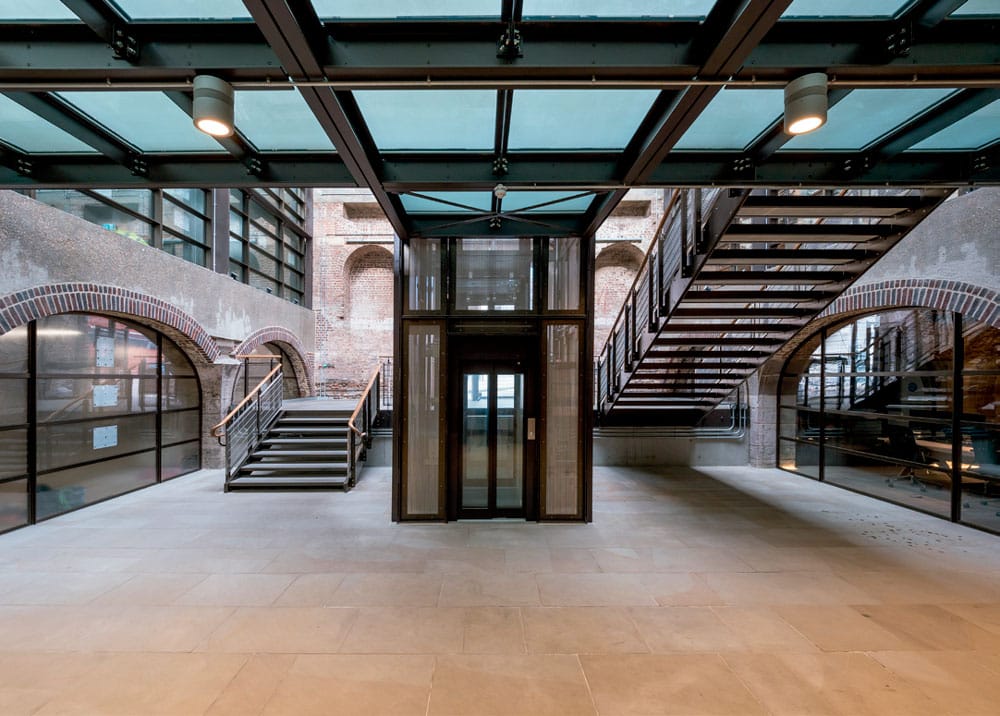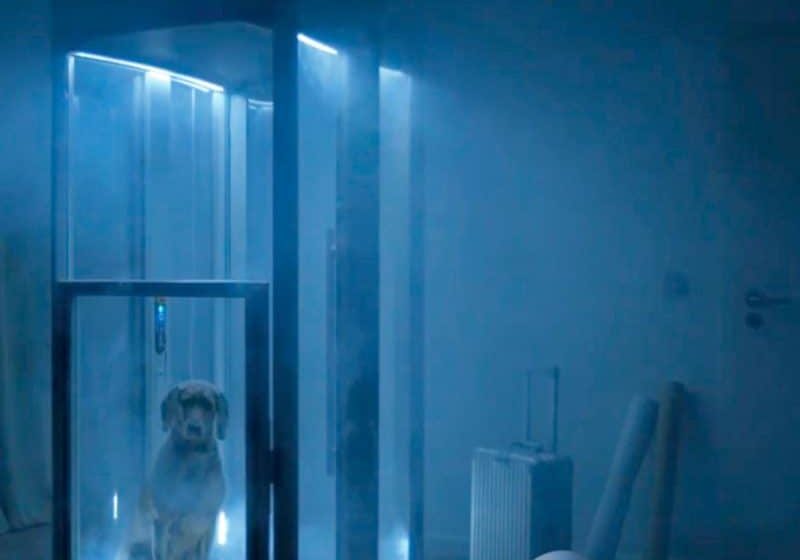The Platform Lift Co. is celebrating 20 years of creating step-free access within a wide range of commercial and residential settings. Your author (BM) learns of company founder Sean O’Sullivan’s (SO) passion for the industry and why he wanted to put passengers at the heart of platform lift design.
BM: How did you first get involved in the platform lift industry?
SO: I began my career as an engineer working for Stannah on passenger and stair lifts. Although I enjoyed my role, I became really interested in the sales side of the company and decided to go back to college and study business. I believe I was the first person within Stannah to shift from engineering to the sales team: it was here I started specialising in platform lifts. It was an unusual choice, as engineers are not normally salespeople, but for me it made perfect sense. Because of my engineering knowledge, every lift I sold fitted perfectly and met the customer’s brief.
Still specialising in platform lifts, I went on to work for Otis and then Gartec, which headhunted me for their sales and marketing team. At that time, the platform lift industry was very much in its infancy — there were hardly any companies which were sole providers of wheelchair lifts. It was typically a small division within a larger lift business. There was not a great deal of choice either; products were utilitarian but looked unsightly, which was frustrating for me, as I was conscious of the user experience. I could not stop thinking that if the products looked more stylish, they could be incorporated front of house to provide dignified access to the building, instead of the user being ushered to a platform lift hidden out of sight because of its appearance or, worse still, having to enter through the trade entrance and use a goods lift.
I felt so strongly about this I decided to go it alone and specialise in design-led accessibility products.
BM: What were the key objectives when you set up the company 20 years ago?
SO: My first aim was to source a range of products of which the Platform Lift Co. could be proud. Instead of selling what can only be likened to a ‘steel box,’ I wanted to put passengers at the heart of platform lift design. Together with my wife and business partner, Elsa, we searched for a manufacturer who was as passionate as we were about quality and aesthetics. After much research, we discovered NTD, a Swedish company which sold only in the Nordics. They manufactured a screw-and-nut enclosed platform lift which went up to 9 m and an open platform lift which could overcome a difference in height of 3 m. With both products, we could specify different colours and a couple of bespoke components — not as many as are available now, but back then, this was music to our ears.
We worked with NTD to rewrite all the technical literature and started selling their products to the U.K. market. Soon after, we added a stair lift to the range from Cama – a Danish-designed product. We quickly realised the beauty of being independent, as we could pick and choose the best products on the market to continually add to or update our range of platform lift solutions.
With some quality products under our belt, I felt confident in tackling my next objective, which was raising awareness that platform lifts could be stylish and incorporated within a reception area or hotel lobby instead of being hidden away. I spent a long time talking to architects, specifiers and end users about what they wanted from a platform lift, and relaying this back to the manufacturers so they could enhance the product.
It was very important to me that the company’s brand image be fresh, modern and innovative, as the platform lift industry at the time of setting up the business was considered old-fashioned. I am always impressed when I visit Swedish companies in their state-of-the-art offices and come back inspired and full of ideas to refurbish our own premises.
Also, from day one, I wanted to make sure we had clear goals and procedures in place so we could offer a fully comprehensive service which included design, build, installation and ongoing maintenance and servicing. This provided us with a solid foundation on which to build the business and ensure a fast and reliable turnaround. Twenty years on, this still keeps the business robust, but is flexible enough that it can continue to grow.
BM: How has the platform lift industry evolved over the years?
SO: Several factors have created a market for platform lifts and advanced their design, including the Equality Act, Part M of the Building Regulations and the growing number of people which require step-free access to buildings and their facilities. For example, in the U.K., the NHS estimates there are 1.2 million wheelchair users, and the charity Scope claims there are now 14.1 million disabled people. The spending power of disabled people and their households is also increasing: the Purple Pound is now estimated to be worth £274 billion per year to U.K. business.
Initiatives such as Purple Tuesday, the U.K.’s first accessible shopping day, is also driving the market for accessibility products. Likewise, social media platforms, such as Trip Advisor and Facebook, where people can report their daily experiences and frustrations, such as a station not having step-free access, having a broken down lift or lacking accessible housing, is putting more and more pressure on businesses — and the government — to take action.
The fact that a platform lift is cheaper, more energy efficient, easier to install than a passenger lift and takes up much less space than fitting a ramp has provided an ideal solution for a variety of sectors, including hospitality, leisure, education, tourism, sports and transport.
Having recognised the potential of platform lifts 20 years ago, I have managed to keep the business at the forefront of the industry by developing our product range and working with manufacturers to offer customers the latest, most stylish, innovative, quality engineered platform lifts available. As a business, we have also developed an attractive collection of residential platform lifts for easy living and for those looking to ‘future proof’ their homes.
BM: Has the design of platform lifts completely changed since you first started?
SO: We have gone from what can only be described as a steel box to aesthetically pleasing, architecturally designed platform lifts. We now install platform lifts front of house and in people’s homes. You can have any RAL colour, choose from a variety of finishes and enjoy seamless glazing on all four sides. Enclosed vertical platform lifts (VPL) serve up to six levels and come with their own self-supporting shaft, making them ideal for heritage buildings. Products are engineered for quiet, smooth operation and designed with incredibly small footprints. In fact, apart from the lower speed, it is hard to tell the difference between a passenger lift and a cabin-style VPL — the user experience is largely similar.
With better control systems and superior components, we are now seeing zero failure rates with products such the Motala 2000, our most popular commercial platform lift. This product also wins on energy efficiency because of its unique patented drive system with controlled chain, which requires minimal maintenance. It has a motor size of 0.55kW against a typical 2.2KW platform lift, and uses a 10A fuse, which results in significantly lower operating costs.
BM: With more than 4,000 installations, which ones have been the most memorable or challenging?
SO: That is a difficult question, as when I walk around London, I am incredibly proud to see so many of our platform lifts installed. However, when I travel on the underground, I cannot help but feel a huge sense of satisfaction knowing that we successfully designed, built and installed platform lifts at some of the stations.
You can imagine in this industry it’s not unusual to carry out access surveys in all sorts of buildings, but the one which sticks in my mind is Fordwich Town Hall. The Grade II*-listed building was built around 1544 and, over the years, has served as a courtroom, a meeting place for the local council and, more recently, a wedding venue and tourist attraction. However, with no disabled access to the first floor, its potential use as a community and function space was limited.
My design team and I worked closely with the much-acclaimed architect John Sell of Sell Wade Consultants, former chairman of SPAB (Society for the Protection of Ancient Buildings), on the style of the lift. It was important that its appearance did not in any way try to look like it was part of the building; it needed its own identity, clearly showing modern design. The clean lines of the open style platform lift fitted in harmoniously with the historic building because of the well-thought-out design.
BM: What have been your biggest milestones?
SO: We have gone from being a two-man team to having our own stylish offices, complete with showroom, a team of 20 staff and a network of subcontractors which enable us to cover the whole of the U.K. Having everything under one roof means the business can offer a fully comprehensive service, which can fulfil the whole lifecycle of a platform lift, from its initial design right through to installation, servicing and being fully upgraded. We have become a one-stop shop for platform lifts and can offer training, parts, servicing and maintenance.
Now that we are a key U.K. distributor for the Motala range of products, our plan is to increase our network of trade partners and develop our sales tool kit, which features an online quotation tool. We are also investing in our parts, servicing and maintenance department, which will become a separate division of the business.
As well as successfully achieving 20 years of trading, our most recent triumph is gaining our ISO 14001 and ISO 45001 certifications, which proves our commitment to the environment and to maintaining high health and safety standards. This is a valuable addition to our ISO 9001 accreditation, which the Platform Lift Co. has held since 2003.
BM: What do you think the key to success is for running a small or medium-sized enterprise (SME)?
SO: Being a smaller independent business enables you to be more agile. For example, during the pandemic, we were able to remain fully operational, which was fortunate as the sales leads kept coming in. A lot of the bigger companies needed to furlough staff, which meant customers who could not get quotes came to us. We started to see a new audience.
I also think, because we are smaller and have everything in house, it is easier to move with the times and be innovative as reflected in our Platform Lift Protect Package which we created in response to COVID-19. Businesses now have the option to upgrade their platform lift with touchless buttons, antimicrobial coating and an air purifier.
For us, other key ingredients have been a good customer relationship management system, having robust procedures in place and a flat management structure where everyone is of equal importance and has a role to play within the organisation. We encourage members of our team to structure their day as if they were running their own business. As a result, the atmosphere is relaxed but very professional. Our team is hardworking, loyal and forward-thinking.
Get more of Elevator World. Sign up for our free e-newsletter.










